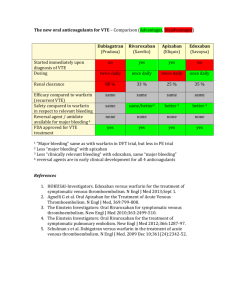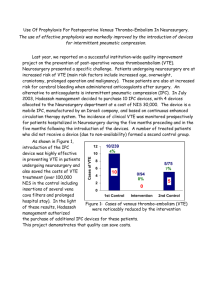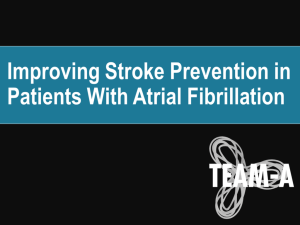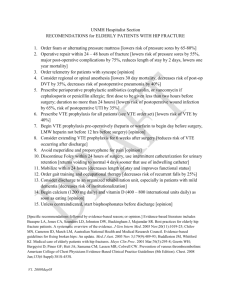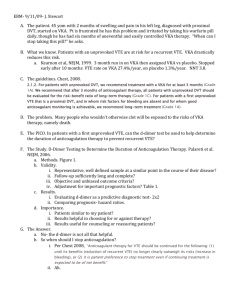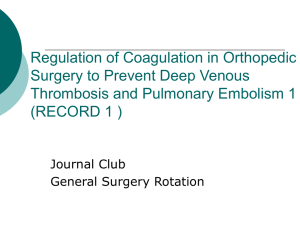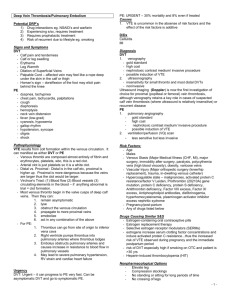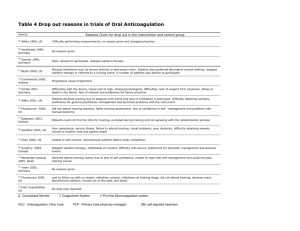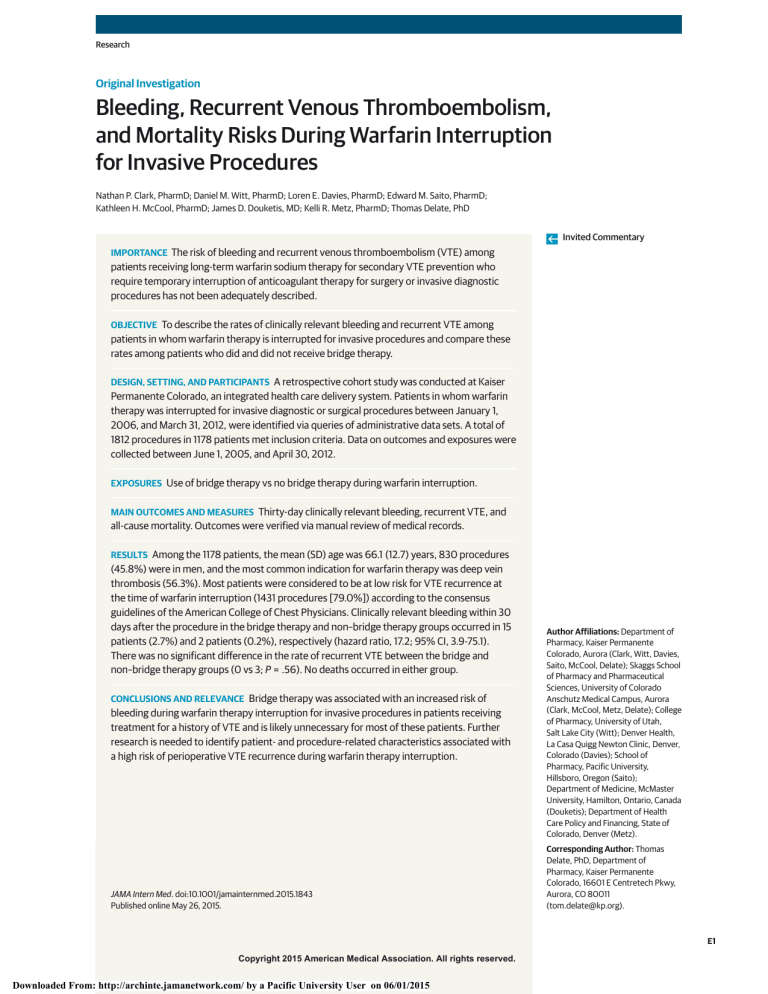
Research
Original Investigation
Bleeding, Recurrent Venous Thromboembolism,
and Mortality Risks During Warfarin Interruption
for Invasive Procedures
Nathan P. Clark, PharmD; Daniel M. Witt, PharmD; Loren E. Davies, PharmD; Edward M. Saito, PharmD;
Kathleen H. McCool, PharmD; James D. Douketis, MD; Kelli R. Metz, PharmD; Thomas Delate, PhD
Invited Commentary
IMPORTANCE The risk of bleeding and recurrent venous thromboembolism (VTE) among
patients receiving long-term warfarin sodium therapy for secondary VTE prevention who
require temporary interruption of anticoagulant therapy for surgery or invasive diagnostic
procedures has not been adequately described.
OBJECTIVE To describe the rates of clinically relevant bleeding and recurrent VTE among
patients in whom warfarin therapy is interrupted for invasive procedures and compare these
rates among patients who did and did not receive bridge therapy.
DESIGN, SETTING, AND PARTICIPANTS A retrospective cohort study was conducted at Kaiser
Permanente Colorado, an integrated health care delivery system. Patients in whom warfarin
therapy was interrupted for invasive diagnostic or surgical procedures between January 1,
2006, and March 31, 2012, were identified via queries of administrative data sets. A total of
1812 procedures in 1178 patients met inclusion criteria. Data on outcomes and exposures were
collected between June 1, 2005, and April 30, 2012.
EXPOSURES Use of bridge therapy vs no bridge therapy during warfarin interruption.
MAIN OUTCOMES AND MEASURES Thirty-day clinically relevant bleeding, recurrent VTE, and
all-cause mortality. Outcomes were verified via manual review of medical records.
RESULTS Among the 1178 patients, the mean (SD) age was 66.1 (12.7) years, 830 procedures
(45.8%) were in men, and the most common indication for warfarin therapy was deep vein
thrombosis (56.3%). Most patients were considered to be at low risk for VTE recurrence at
the time of warfarin interruption (1431 procedures [79.0%]) according to the consensus
guidelines of the American College of Chest Physicians. Clinically relevant bleeding within 30
days after the procedure in the bridge therapy and non–bridge therapy groups occurred in 15
patients (2.7%) and 2 patients (0.2%), respectively (hazard ratio, 17.2; 95% CI, 3.9-75.1).
There was no significant difference in the rate of recurrent VTE between the bridge and
non–bridge therapy groups (0 vs 3; P = .56). No deaths occurred in either group.
CONCLUSIONS AND RELEVANCE Bridge therapy was associated with an increased risk of
bleeding during warfarin therapy interruption for invasive procedures in patients receiving
treatment for a history of VTE and is likely unnecessary for most of these patients. Further
research is needed to identify patient- and procedure-related characteristics associated with
a high risk of perioperative VTE recurrence during warfarin therapy interruption.
JAMA Intern Med. doi:10.1001/jamainternmed.2015.1843
Published online May 26, 2015.
Author Affiliations: Department of
Pharmacy, Kaiser Permanente
Colorado, Aurora (Clark, Witt, Davies,
Saito, McCool, Delate); Skaggs School
of Pharmacy and Pharmaceutical
Sciences, University of Colorado
Anschutz Medical Campus, Aurora
(Clark, McCool, Metz, Delate); College
of Pharmacy, University of Utah,
Salt Lake City (Witt); Denver Health,
La Casa Quigg Newton Clinic, Denver,
Colorado (Davies); School of
Pharmacy, Pacific University,
Hillsboro, Oregon (Saito);
Department of Medicine, McMaster
University, Hamilton, Ontario, Canada
(Douketis); Department of Health
Care Policy and Financing, State of
Colorado, Denver (Metz).
Corresponding Author: Thomas
Delate, PhD, Department of
Pharmacy, Kaiser Permanente
Colorado, 16601 E Centretech Pkwy,
Aurora, CO 80011
(tom.delate@kp.org).
(Reprinted) E1
Copyright 2015 American Medical Association. All rights reserved.
Downloaded From: http://archinte.jamanetwork.com/ by a Pacific University User on 06/01/2015
Research Original Investigation
Risks During Warfarin Interruption for Invasive Procedures
P
atients who are receiving warfarin sodium for the secondary prevention of venous thromboembolism (VTE)
and require interruption of anticoagulant therapy for an
invasive diagnostic or surgical procedure present a common
dilemma for clinicians. Optimally, the balance between procedure-related bleeding and recurrent VTE should be assessed. If the risk of bleeding is low, warfarin use may be continued throughout the procedure.1 Warfarin interruption is
required for several days before the procedure when the risk
of bleeding is high or moderate. When paired with the delayed onset of anticoagulation after resumption of treatment
with warfarin, the risk of recurrent VTE in the perioperative
period may increase.
The use of a short-acting anticoagulant, typically lowmolecular-weight heparin, during the periprocedural period
has been suggested1 for patients at high risk of VTE recurrence to minimize this risk. This strategy, commonly referred
to as bridge therapy, reduces exposure to subtherapeutic anticoagulation for 3 or 4 days during warfarin therapy withdrawal before the procedure and 5 or more days after the procedure during warfarin therapy reinitiation. Risk estimates for
bleeding and VTE associated with bridge therapy in realworld patients with VTE who are receiving anticoagulant
therapy are lacking.2 Cohort studies1,3-7 have largely focused
on patients at risk for stroke due to atrial fibrillation or thrombosis related to mechanical heart valves.
Deciding which patients with VTE should receive bridge
therapy depends primarily on the estimated risk of recurrent
VTE in the periprocedural period. The Antithrombotic Therapy
and Prevention of Thrombosis, Ninth Edition (AT9) guidelines2
classify periprocedural risk as high (>10% per year), moderate (5%-10% per year), and low (<5% per year) depending on
the annual risk of recurrence without anticoagulant therapy.
However, this risk stratification scheme is based on indirect
evidence from studies outside of the perioperative setting and
receives a 2C grade (ie, weak recommendation with low quality evidence from observational studies or case series).
Providing real-world rates of bleeding and VTE in this population has the potential to clarify risk-benefit analysis of bridge
therapy and identify patients in whom warfarin therapy may
be safely interrupted without bridge therapy. The aim of the
present study was to provide and compare real-world rates of
clinically relevant bleeding and recurrent VTE among patients receiving warfarin for a prior VTE in whom treatment
was interrupted for invasive procedures and either did or did
not receive bridge therapy.
Table 1. Recurrent Venous Thromboembolism Risk Stratification
AT9 Risk
Category
Criteria
High
Acute VTE within past 3 mo; severe thrombophilia (deficiency of
protein C, protein S, or antithrombin; antiphospholipid antibody
syndrome; or multiple abnormalities)
Medium
Acute VTE within past 3-12 mo; nonsevere thrombophilia
(heterozygous factor V Leiden, prothrombin 20210 mutation,
increased factor VIII activity); recurrent VTE; or active cancer
Low
Acute VTE >12 mo previously; no other risk factors
Abbreviations: AT9, Antithrombotic Therapy and Prevention of Thrombosis,
Ninth Edition; VTE, venous thromboembolism.
Service (CPAAS).8 Periprocedural warfarin therapy plans are
developed by CPAAS pharmacists using a collaborative drug
therapy management guideline and approved by referring physicians. Detailed information regarding each periprocedural
plan is recorded in an electronic patient tracking tool (DAWN
AC, 4S Information Systems, Ltd) and the electronic medical
record. All study activities were approved by the KPCO institutional review board. Because of the retrospective, dataonly nature of the study and with approval from the KPCO institutional review board, patient informed consent was not
obtained.
Study Population
This study included consecutive patients who underwent an
invasive diagnostic or surgical procedure (index procedure) between January 1, 2006, and March 31, 2012, and who (1) were
at least aged 18 years at the time of the index procedure, (2)
were monitored by the CPAAS, (3) were receiving warfarin
therapy for secondary prevention of VTE (defined as deep vein
thrombosis of the upper or lower extremity and/or pulmonary embolism), (4) had an international normalized ratio of
1.5 or lower on the day of or the day before the index procedure, (5) had at least 180 consecutive days of Kaiser Foundation Health Plan membership before the procedure, (6) resumed warfarin therapy within 30 days after the procedure,
and (7) did not have another procedure-related interruption
of warfarin therapy within 90 days after the index procedure
date. Patients with an indication for warfarin other than VTE
(eg, atrial fibrillation and mechanical heart valve) were excluded. Patients were stratified (high, moderate, or low) according to their underlying risk for recurrent VTE in accordance with the AT9 guidelines (Table 1).2
Study Outcomes
Methods
Study Design and Setting
This retrospective cohort study was conducted at Kaiser Permanente Colorado (KPCO), an integrated health care delivery system providing care to more than 540 000 members. Each year
approximately 2400 procedures requiring coordination of periprocedural warfarin therapy are performed at KPCO. Anticoagulation services at KPCO are provided by the centralized, telephone-based Clinical Pharmacy Anticoagulation and Anemia
E2
The primary outcome of the study was clinically relevant bleeding (defined as any clinically overt bleeding, regardless of severity, resulting in hospitalization or an emergency department visit or that complicated the procedure) occurring up to
30 days following the index procedure. Secondary outcomes
included major bleeding, recurrent VTE, and all-cause mortality occurring up to 30 days following the index procedure.
Thirty-day rates were chosen because it has been suggested9
that this time may best predict procedure-related events. Major bleeding was a subset of the clinically relevant bleeding
events that also met the criteria for major bleeding set forth
JAMA Internal Medicine Published online May 26, 2015 (Reprinted)
Copyright 2015 American Medical Association. All rights reserved.
Downloaded From: http://archinte.jamanetwork.com/ by a Pacific University User on 06/01/2015
jamainternalmedicine.com
Risks During Warfarin Interruption for Invasive Procedures
by the Subcommittee on Control of Anticoagulation of the Scientific and Standardization Committee of the International Society on Thrombosis and Haemostasis.10
Data Collection
Potential study patients were identified using KPCO electronic administrative data sets supplemented by manual reviews of medical records using a structured data abstraction
form. The KPCO membership database was used to confirm
health plan membership eligibility and identify deaths during the follow-up period. Information pertaining to the type
of invasive procedure necessitating interruption of warfarin
therapy (gastrointestinal tract endoscopy; spinal or intracranial; orthopedic; dermatologic; abdominal or thoracic [major
and non-major]; urologic; dental; vascular; ears, eyes, nose,
and throat; and pacemaker or implantable cardiac defibrillator procedures, as well as other procedure types) was gathered from DAWN AC. Bleeding and recurrent VTE events were
identified administratively using predefined International Classification of Diseases, Ninth Revision (ICD-9) diagnosis codes
and confirmed via manual review of the medical records by 2
study team members (N.P.C. and L.E.D. or E.M.S.) using a standardized abstraction form, with disagreements resolved by a
third reviewer (D.M.W.). Recurrent thromboembolism required objective confirmation of new thrombosis or thrombus extension on duplex ultrasonography, ventilation or perfusion scanning, or computed tomographic angiography.
Comorbidities (eg, alcoholism, stroke or systemic embolism, diabetes mellitus, heart failure, hypertension, and renal
insufficiency) present in the 180 days before the index procedure were identified administratively using predefined ICD-9
codes. Patients with cancer were identified administratively
from queries of the KPCO Tumor Registry. Active cancer was
defined as the reception of chemotherapy or other cancerrelated treatment (eg, hormonal therapy), cancer-related surgery, or cancer-related radiotherapy during the 180 days before the index procedure. The presence of thrombophilia was
identified administratively using DAWN AC and KPCO laboratory records and was verified via manual review of the medical records when necessary. The use of bridge therapy was determined by identifying purchases of parenteral anticoagulants
recorded in the KPCO pharmacy database and manual review
of periprocedural plans recorded in DAWN AC.
Statistical Analysis
Data on outcomes and exposures were collected between June
1, 2005, and April 30, 2012. All procedures meeting inclusion
criteria were included in the analysis, and multiple procedures in the same patient could be included provided that each
met the inclusion criteria and was separated from the other procedures by at least 90 days. No formal power calculation was
performed because all procedures fitting inclusion and exclusion criteria were analyzed. Patient characteristics were summarized using descriptive statistics. Thirty-day bleeding and
thromboembolic rates were calculated by dividing the counts
of each event by the total number of included procedures and
multiplying by 100. Rates are reported as percentages with 95%
CIs. Because multiple procedures were included for some pajamainternalmedicine.com
Original Investigation Research
Figure. Patient Algorithm
18 897 Procedures occurred between January 1, 2006,
and March 31, 2012, in patients monitored
by the Clinical Pharmacy Anticoagulation and
Anemia Growth Factor Service
Exclusions
1 Patient aged <18 y
11 710 Warfarin indication other than VTE
4043 INR >1.5 on or the day before the procedure
136 Patient had <180 consecutive days of Kaiser
Foundation Health Plan membership
1002 Warfarin therapy not resumed within 30 d
after procedure
193 Another procedure-related warfarin therapy
interruption within 90 d after procedure
1812 Procedures included in analysis
INR indicates international normalized ratio; VTE, venous thromboembolism.
Warfarin was given as warfarin sodium.
tients, conditional unadjusted logistic analyses and linear regression analyses were used to compare categorical and continuous variables, respectively. Unadjusted Cox proportional
hazards regression modeling was used to determine the hazard ratio of 30-day bleeding and its 95% CI. Patients were censored on the date of bleeding or 30 days after their procedure,
whichever came first. Because of the low rate of outcome
events, adjustment for potential confounders was not possible. Subanalyses were performed by assessing the bleeding
outcome using only a patient’s first procedure during the study
period and between patients who received a therapeutic vs prophylactic bridging dose. Statistical analysis was performed
using SAS, version 9.2 (SAS Institute Inc), and Stata, version
9.2 (StataCorp).
Results
There were 1812 procedures in 1178 patients who met the inclusion criteria (Figure). The mean (SD) age of the overall cohort was 66.1 (12.7) years; 830 procedures (45.8%) were in men;
1021 (56.3%) and 791 (43.7%) were receiving warfarin treatment for deep vein thrombosis (upper or lower extremity) and
pulmonary embolism, respectively, and 175 (9.7%) had confirmed thrombophilia (Table 2). Warfarin therapy was interrupted most commonly for gastrointestinal tract endoscopic
procedures (673 [37.1%]), followed by orthopedic (247 [13.6%]),
spinal or intracranial (175 [9.7%]), and nonmajor abdominal or
thoracic (155 [8.6%]) procedures. When stratified by the AT9
guideline for recurrent VTE risk classification, 1431 (79.0%) procedures were in low-risk, 324 (17.9%) in moderate-risk, and 57
(3.1%) in high-risk patients. Bridge therapy was administered
in 410 of 1431 (28.7%), 109 of 324 (33.6%), and 36 of 57 (63.2%)
procedures performed in low-, moderate-, and high-risk patients, respectively. Of the 555 bridge therapy plans, 401 plans
(72.5%) and 154 plans (27.8%) used therapeutic and prophylactic doses, respectively.
(Reprinted) JAMA Internal Medicine Published online May 26, 2015
Copyright 2015 American Medical Association. All rights reserved.
Downloaded From: http://archinte.jamanetwork.com/ by a Pacific University User on 06/01/2015
E3
Research Original Investigation
Risks During Warfarin Interruption for Invasive Procedures
Table 2. Patient and Procedure Characteristics by Bridging Status
No. (%)
Characteristic
Overall
(N = 1812)
Bridge Therapy
(n = 555)
No Bridge Therapy
(n = 1257)
P Value
67.7 (12.1)
<.001
Patient
Age, mean (SD), y
Male sex
66.1 (12.7)
62.5 (13.3)
830 (45.8)
262 (47.2)
568 (45.2)
.43
DVT LE
930 (51.3)
267 (48.1)
663 (52.7)
.15
DVT UE
91 (5.0)
27 (4.9)
64 (5.1)
791 (43.7)
261 (47.0)
530 (42.2)
Hypertension
853 (47.1)
243 (43.8)
610 (48.5)
.06
Diabetes mellitus
305 (16.8)
88 (15.9)
217 (17.3)
.46
Renal insufficiency
192 (10.6)
51 (9.2)
141 (11.2)
.20
Heart failure
16 (0.9)
6 (1.1)
10 (0.8)
.55
Alcoholism
31 (1.7)
9 (1.6)
22 (1.8)
.85
<3
24 (1.3)
18 (3.2)
6 (0.5)
<.001
3-12
51 (2.8)
21 (3.8)
30 (2.4)
.10
>12
1737 (95.9)
516 (93.0)
1221 (97.1)
<.001
Recurrent VTE
195 (10.8)
81 (14.6)
114 (9.1)
<.001
Active cancer
53 (2.9)
19 (3.4)
34 (2.7)
.40
33 (1.8)
18 (3.2)
15 (1.2)
.003
142 (7.8)
53 (9.5)
89 (7.1)
.07
<.001
Indication
PE
Comorbidity diagnosis
VTE proximity to procedure, mo
Positive thrombophilia test
Severea
Nonsevereb
Recurrent VTE risk categoryc
High
Medium
Low
57 (3.1)
36 (6.5)
21 (1.7)
324 (17.9)
109 (19.6)
215 (17.1)
.22
1431 (79.0)
410 (73.9)
1021 (81.2)
<.001
Procedure
Type
Gastrointestinal endoscopy
673 (37.1)
187 (33.7)
486 (38.7)
.04
Orthopedic
247 (13.6)
118 (21.3)
129 (10.3)
<.001
Spinal or intracranial
175 (9.7)
24 (4.3)
151 (12.0)
<.001
Nonmajor abdominal or thoracic
155 (8.6)
81 (14.6)
74 (5.9)
<.001
Dermatologic
111 (6.1)
21 (3.8)
90 (7.2)
.006
Urologic or bladder
102 (5.6)
26 (4.7)
76 (6.1)
.25
74 (4.1)
25 (4.5)
49 (3.9)
.55
Vascular
Dental
61 (3.4)
5 (0.9)
56 (4.5)
<.001
EENT
53 (2.9)
14 (2.5)
39 (3.1)
.50
Major abdominal or thoracic
35 (1.9)
17 (3.1)
18 (1.4)
.02
Pacemaker or ICD
11 (0.6)
4 (0.7)
7 (0.6)
.75
115 (6.4)
33 (5.9)
82 (6.5)
.64
Other
Primary Outcome
The 30-day rates of clinically relevant bleeding among the bridge
and non–bridge therapy groups were 2.7% (15 events; 95% CI,
1.5%-4.4%) and 0.2% (2 events; 95% CI, 0.02%-0.6%), respectively
(hazard ratio, 17.2; 95% CI, 3.9-75.1) (Table 3). Subanalysis using
only the first procedure for each patient provided similar results
(30-day rates of clinically relevant bleeding among the bridge and
non–bridge therapy groups were 3.0% and 0.3%, respectively;
P < .001). There were 9 (2.2%) and 6 (3.9%) 30-day clinically relevant bleeding events among patients who received a therapeutic or prophylactic dose of a bridge anticoagulant, respectively
E4
Abbreviations: DVT, deep vein
thrombosis; EENT, ears, eyes, nose,
and throat; EGD, esophagogastroduodenoscopy; ICD, implanted
cardioverter/defibrillator; LE, lower
extremity; PE, pulmonary embolism;
UE, upper extremity; VTE, venous
thromboembolism.
a
Includes protein C, protein S,
or antithrombin deficiency;
antiphospholipid antibodies;
homozygous factor V Leiden;
homozygous prothrombin 20210
mutation; or multiple thrombophilic
traits.
b
Includes heterozygous factor V
Leiden or heterozygous
prothrombin 20210 mutation.2
c
See Table 1 for risk factors.
(P = .28). Of the 15 bleeding events occurring in the bridge cohort,
9 (52.9%) were procedure complications and 5 (33.3%) were directly related to bridging agent injections (eg, rectus sheath hematoma). Bleeding complications occurred most frequently in
pacemaker or implantable cardiac defibrillator (n = 11), urologic
(n = 102), and vascular (n = 74) procedures (1 [9.1%], 3 [2.9%], and
2 [2.7%] complications, respectively).
Secondary Outcomes
Recurrent VTE complication rates were not significantly different between bridging status groups or across AT9 guide-
JAMA Internal Medicine Published online May 26, 2015 (Reprinted)
Copyright 2015 American Medical Association. All rights reserved.
Downloaded From: http://archinte.jamanetwork.com/ by a Pacific University User on 06/01/2015
jamainternalmedicine.com
Risks During Warfarin Interruption for Invasive Procedures
Original Investigation Research
Table 3. Outcomes at 30 Days Overall and by Bridging Status and VTE Risk Categorya
No./Total No. (%)
Outcome
Overall
(N = 1812)
Bridge Therapy
(n = 555)
No Bridge Therapy
(n = 1257)
P Value
Clinically Relevant Bleeding
Risk
High
3/57 (5.3)
2/36 (5.6)
1/21 (4.8)
.90
Moderate
5/324 (1.5)
5/109 (4.6)
0/215
.004
9/1431 (0.6)
8/410 (2.0)
1/1021 (0.1)
<.001
17/1812 (0.9)
15/555 (2.7)
2/1257 (0.2)
.01
Low
Overall
Recurrent VTE
Abbreviation: VTE, venous
thromboembolism.
Risk
High
0/57
0/36
0/21
Moderate
1/324 (0.3)
0/109
1/215 (0.5)
.48
Low
2/1431 (0.1)
0/410
2/1021 (0.2)
.37
Overall
3/1812 (0.2)
0/555
3/1257 (0.2)
.56
line risk categories (P = .56) (Table 3). No recurrent VTE events
occurred in high-risk patients. No 30-day deaths occurred in
either group. Of the 17 clinically relevant bleeding events in
the cohort, 14 met the definition of major bleeding (0.8% of
all procedures). Major bleeding occurred in 12 bridge therapy
procedures (2.2%) and 2 of the non–bridge therapy procedures (0.2%) (P < .001).
Discussion
The use of a bridge agent among patients receiving long-term
anticoagulation therapy for a history of VTE was associated
with a 17-fold higher risk of bleeding without a significant difference in the rate of recurrent VTE. Bleeding rates in patients in the bridge therapy group who experienced clinically
relevant bleeding did not differ significantly between those receiving therapeutic and prophylactic doses of the bridge
therapy agent. Bleeding was either directly attributed to the
administration of the bridging agent or a complication of the
procedure in most cases. Conversely, recurrent VTE events
were rare in both the bridge and non–bridge therapy groups,
including within the non–bridge therapy high-risk subgroup.
Thus, the risk of bleeding associated with bridge therapy appeared to outweigh the potential benefits in our study population. Our results highlight the need for further research to
identify patient- or procedure-related characteristics that predict a high risk of VTE recurrence during interruption of warfarin therapy.
The rates of bleeding and recurrent thrombosis observed
in our study are similar to those reported elsewhere. A retrospective cohort study11 compared rates of recurrent VTE and
major bleeding during periprocedural management stratified
by the acuity of the original VTE event. A higher rate of major
bleeding was observed among low-risk bridge therapy compared with nonbridge therapy (2.5% vs 0.9%, respectively) and
a low rate of recurrent VTE across all risk groups. A second retrospective cohort study12 of patients with a history of VTE in
whom warfarin therapy was interrupted periprocedurally reported 30-day major bleeding and VTE rates of 1.26% (95% CI,
jamainternalmedicine.com
>.99
a
Risk categorized as high (>10% per
year), moderate (5%-10% per year),
and low (<5% per year) depending
on the annual risk of recurrence
without anticoagulant therapy.
0.64%-2.47%) and 0.3% (95% CI, 0.1%-1.1%), respectively. Approximately one-fourth (24.6%) of the cohort received bridge
therapy, but no significant difference was found in the risk of
recurrent VTE between the bridge and nonbridge groups. As
a result, the authors concluded that a nonbridged periprocedural approach was promising for patients who were receiving anticoagulant therapy for a history of VTE. Finally, a recent systematic review and meta-analysis13 analyzed outcomes
of periprocedural anticoagulation management in studies in
which approximately 22% of the patients were receiving warfarin therapy for a prior VTE. Their analysis reinforces a low
overall rate of recurrent thromboembolism among patients
with a history of VTE who received bridge therapy compared
with those who did not (0.6% vs 0.9%; odds ratio [OR], 0.80;
95% CI, 0.42-1.54). In contrast, use of bridge therapy was associated with an increased risk for major bleeding (OR, 3.60;
95% CI, 1.52-8.50), although the affect was not as pronounced as in our analysis. The authors13 concluded that bridge
therapy may be avoided in patients not deemed to be at high
risk for recurrent VTE.
Our results confirm and strengthen the findings of those
previous studies and highlight the need for a risk categorization scheme that identifies patients at highest risk for recurrent VTE who may benefit from bridge therapy. In addition,
our results suggest that the AT9 guideline moderate and low
recurrent VTE risk categories could be combined since there
appears to be little, if any, risk difference between them. It is
also noteworthy that most of our bridge cohort was categorized as being at low risk for recurrent VTE. It is possible that
other patient- and procedure-specific factors not captured by
the AT9 guideline recommendations influenced the decision
to use bridge therapy in such patients, including VTE recurrence during a previous interruption of warfarin therapy, high
procedure-related VTE risk (eg, joint replacement surgery), and
patient or provider preference.
There are several limitations inherent in our retrospective study design. First, the use of administratively collected
data may have resulted in omitted or misclassified procedures and outcomes. We performed manual checks to mitigate this risk and ensure that data were categorized as accu(Reprinted) JAMA Internal Medicine Published online May 26, 2015
Copyright 2015 American Medical Association. All rights reserved.
Downloaded From: http://archinte.jamanetwork.com/ by a Pacific University User on 06/01/2015
E5
Research Original Investigation
Risks During Warfarin Interruption for Invasive Procedures
rately as possible, but we cannot exclude the possibility that
some patients may have received bridge therapy without our
knowledge, especially during procedures requiring hospitalization. However, proceduralists approve CPAAS plans for anticoagulation management a priori, thereby limiting the possibility of unknown use of bridge therapy. Second, owing to
the overall low event rates, especially among the high-risk subgroup, we were unable to adjust the outcomes for potential confounding. In addition, we identified only a small number of patients at high risk for VTE who did not receive bridge therapy.
Most of the patients included in this analysis had received longterm (>12 months) anticoagulation for VTE before the procedure. Most of these patients likely had idiopathic VTE, but we
were unable to definitively categorize patients’ VTE history according to provoked vs idiopathic status. However, we be-
ARTICLE INFORMATION
Accepted for Publication: March 24, 2015.
Published Online: May 26, 2015.
doi:10.1001/jamainternmed.2015.1843.
Author Contributions: Drs Clark and Delate had
full access to all the data in the study and take
responsibility for the integrity of the data and the
accuracy of the data analysis.
Study concept and design: Clark, Witt, Davies, Saito,
McCool, Douketis, Delate.
Acquisition, analysis, or interpretation of data: Witt,
Davies, Saito, Douketis, Metz, Delate.
Drafting of the manuscript: Clark, Witt, Davies,
Saito, Douketis, Metz.
Critical revision of the manuscript for important
intellectual content: Clark, Witt, Davies, Saito,
McCool, Douketis, Delate.
Statistical analysis: Witt, Saito, Delate.
Administrative, technical, or material support: Metz,
Delate.
Study supervision: Clark, Witt.
Conflict of Interest Disclosures: Dr Douketis
reports being a consultant for BoerhingerIngelheim and serving as a consultant during 4
advisory board meetings (Astra-Zeneca,
Boehringer-Ingelheim, Pfizer, and Sanofi) relating
to the development and clinical use of novel, but
not approved for clinical use, antiplatelet drugs
(ticagrelor) and anticoagulant drugs (apixaban,
dabigatran, and semuloparin). No other disclosures
were reported.
E6
lieve our results offer a unique perspective of real-world outcomes in patients receiving warfarin for secondary VTE
prevention, many of whom would have received bridge therapy
in other health care systems.
Conclusions
Bridge therapy was associated with an increased risk of bleeding during interruption of warfarin therapy for invasive procedures in patients with a history of VTE and is likely unnecessary for most of these patients. Further research is needed
to identify patient- and procedure-related characteristics associated with a high risk of perioperative VTE recurrence during interruption of warfarin therapy.
Western States Conference for Pharmacy
Residents, Fellows, and Preceptors in San Diego,
California, for fulfillment of their postgraduate year
2 pharmacy residency program requirements.
REFERENCES
1. Garcia DA, Regan S, Henault LE, et al. Risk of
thromboembolism with short-term interruption of
warfarin therapy. Arch Intern Med. 2008;168(1):
63-69.
2. Douketis JD, Spyropoulos AC, Spencer FA, et al;
American College of Chest Physicians. Perioperative
management of antithrombotic therapy:
Antithrombotic Therapy and Prevention of
Thrombosis, 9th ed: American College of Chest
Physicians Evidence-Based Clinical Practice
Guidelines. Chest. 2012;141(2)(suppl):e326S-e350S.
doi:10.1378/chest.11-2298.
3. Birnie DH, Healey JS, Wells GA, et al; BRUISE
CONTROL Investigators. Pacemaker or defibrillator
surgery without interruption of anticoagulation.
N Engl J Med. 2013;368(22):2084-2093.
4. Douketis JD, Johnson JA, Turpie AG.
Low-molecular-weight heparin as bridging
anticoagulation during interruption of warfarin:
assessment of a standardized periprocedural
anticoagulation regimen. Arch Intern Med. 2004;
164(12):1319-1326.
weight heparin for patients at risk of arterial
embolism who require temporary interruption of
warfarin. Circulation. 2004;110(12):1658-1663.
8. Witt DM, Sadler MA, Shanahan RL, Mazzoli G,
Tillman DJ. Effect of a centralized clinical pharmacy
anticoagulation service on the outcomes of
anticoagulation therapy. Chest. 2005;127(5):
1515-1522.
9. Spyropoulos AC, Douketis JD, Gerotziafas G,
Kaatz S, Ortel TL, Schulman S; Subcommittee on
Control of Anticoagulation of the SSC of the ISTH.
Periprocedural antithrombotic and bridging
therapy: recommendations for standardized
reporting in patients with arterial indications for
chronic oral anticoagulant therapy. J Thromb
Haemost. 2012;10(4):692-694.
10. Schulman S, Angerås U, Bergqvist D, Eriksson B,
Lassen MR, Fisher W; Subcommittee on Control of
Anticoagulation of the Scientific and
Standardization Committee of the International
Society on Thrombosis and Haemostasis. Definition
of major bleeding in clinical investigations of
antihemostatic medicinal products in surgical
patients. J Thromb Haemost. 2010;8(1):202-204.
11. McBane RD, Wysokinski WE, Daniels PR, et al.
Periprocedural anticoagulation management of
patients with venous thromboembolism.
Arterioscler Thromb Vasc Biol. 2010;30(3):442-448.
Funding/Support: This study was conducted at
and funded by Kaiser Permanente Colorado.
5. Dunn AS, Spyropoulos AC, Turpie AG. Bridging
therapy in patients on long-term oral anticoagulants
who require surgery: the Prospective Peri-operative
Enoxaparin Cohort Trial (PROSPECT). J Thromb
Haemost. 2007;5(11):2211-2218.
12. Skeith L, Taylor J, Lazo-Langner A, Kovacs MJ.
Conservative perioperative anticoagulation
management in patients with chronic venous
thromboembolic disease: a cohort study. J Thromb
Haemost. 2012;10(11):2298-2304.
Role of the Funder/Sponsor: The funder had no
role in the design or conduct of the study;
collection, management, analysis, or interpretation
of the data; and preparation, review, or approval of
the manuscript.
6. Jaffer AK, Brotman DJ, Bash LD, Mahmood SK,
Lott B, White RH. Variations in perioperative
warfarin management: outcomes and practice
patterns at nine hospitals. Am J Med. 2010;123(2):
141-150.
Previous Presentations: Portions of this study’s
results were presented by Drs Davies and Saito on
May 14, 2013, and May 12, 2014, respectively, at the
7. Kovacs MJ, Kearon C, Rodger M, et al. Single-arm
study of bridging therapy with low-molecular-
13. Siegal D, Yudin J, Kaatz S, Douketis JD, Lim W,
Spyropoulos AC. Periprocedural heparin bridging in
patients receiving vitamin K antagonists: systematic
review and meta-analysis of bleeding and
thromboembolic rates. Circulation. 2012;126(13):
1630-1639.
JAMA Internal Medicine Published online May 26, 2015 (Reprinted)
Copyright 2015 American Medical Association. All rights reserved.
Downloaded From: http://archinte.jamanetwork.com/ by a Pacific University User on 06/01/2015
jamainternalmedicine.com

